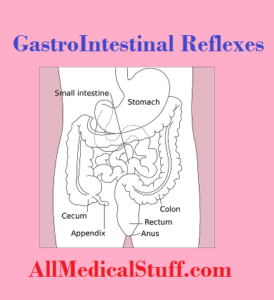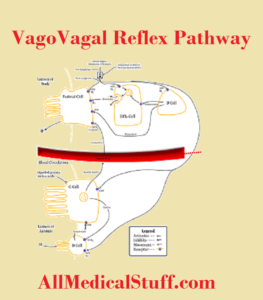GastroIntestinal system of the human body has complex systems. One of the special of which is its own nervous system called Enteric Nervous system which composed of almost 500 millions of neurons which are almost equal to that present in spinal cord. Now via this entric nervous system GIT control its various function like motility, secretions and absorption etc. Not only this, they helps to elicit various GIT reflexes. These reflexes helps to regulate motility ( mixing and peristalsis), secretions, contraction and local inhibitory effects etc of the gut. But all the reflexes are not intrinsic in origin, some are extrinsic as well. Here in this post, we will discuss all types of GastroIntestinal reflexes in detail.
Types of GIT Reflexes:
There are three types of GI reflexes, these are the following:
- Intrinsic GI reflexes OR Local reflexes.
- Extrinsic GI reflexes.
Extrinsic reflexes are further divided into:
- Short Reflexes
- Long Reflexes
Intrinsic GIT Reflexes:
Intrinsic reflexes act via the enteric nervous system. An irritation or distension of gastric muscosa causes stimulation of sensory afferent to intrinsic nuclei. From there efferent signals passes to the required cells such as glands of the stomach or smooth muscles of the gut. As this reflexes (both afferent and efferent) occurs inside git (via enteric system) that’s why it is called intrinsic or local reflexes.
Extrinsic GIT Reflexes:
Extrinsic reflexes are those reflexes in which the afferents passes from the gut to preverterbral sympathetic ganglia or to spinal cord OR brain stem and then back to gut. These are of two types:
Short GI Reflexes:
These are the reflexes from gut to pre vertebral sympathetic ganglia and back to the GIT. These type of reflexes are helpful for transmitting reflexes to far areas of the gut such as reflex from stomach to ilium or from stomach or duodenum to colon etc.
Here is the list of short reflexes:
- Ileogastric Reflex.
- Enterogastric Reflex.
- Gastrocolic Reflex.
- ColonoIleal reflex.
Long GI Reflexes:
These reflexes are called long reflexes because they travel all the way from gut to spinal cord OR Brain stem and back to gastro intestinal tract. These include:
- Vomiting Reflexes.
- Pain Reflexes.
- Vagovagal Reflexes.
- Defecation Reflexes.
GastroColic & Duodenocolic Reflex:
These reflexes results from the distention of stomach or duodenum. These reflexes results in MASS movements in colon after meal. After taking meal, which stomach and duodenum is distended, they send afferent signals to autonomic nerves and efferent results in increased Mass movements in Colon.
These reflexes are mediated via long, short pathway and hormones i.e via both extrinsic and intrinsic. However researches have shown that these reflexes do not, or hardly occur when the extrinsic nerves to the colon are damaged or removed. Which means that it is mainly control via extrinsic pathway.
EnteroGastric Reflex:
When food enters duodenum, a reflex is initialted from the duodenal wall in response to proteins and fats. A reflex is initiated that slows down or even step stomach emptying. This reflex that is initiated in duodenum and travels to stomach is called entero gastric reflex. This reflex acts via 3 pathways.
First, it passes directly from duodenum to stomach via enteric nervous system. Or second, it can also travel via extrinsic pathway (short pathway) to pre vertebral ganglia and back to stomach via inhibitory sympathetic nerves.
Third, it can also occur through vagus nerve (long pathway) upto some extent.
The stimulus for this reflex could be:
- Distention of Duodenum.
- Presence of some degree of irritation in duodenal mucosa
- Degree of acidity in duodenal chyme.
- Osmolality of chyme.
- Large amount of proteins and fats in chyme.
Intestino-Intestinal Reflex:
Distention in one part of intestine causes contraction is another cauded part of intestine to aid peristalsis.
Vago- Vagal Reflex:
In this reflex, both the afferent and efferent fibers are of vagus nerves. Signals in this reflex travels from gut to vagus nuclei in the brain stem and then back to the GI. So, it is a Long Reflex.
Functions:
- It allows the accommodation of large amount of food in stomach.
- In response to distention of gut, it control contraction of GI muscles.
- Afferent fibers carry signals to dorsal vagal complex from chemo receptors, stretch receptors and osmoreceptors.
- Efferent fibers reach gut up to left colic flexure via efferent fibers of vagus nerve.
- Receptive relaxation of stomach during swallowing of food.
Vagovagal reflex pathway:
You can learn the pathway of vagoval reflex from this simple diagram:
Defecation Reflex:
Defecation reflexes are of two types:
- Intrinsic Defecation Reflexes
- Extrinsic Defecation Reflexes
1. Intrinsic Defecation Reflexes:
As the name indicates, these reflexes of GIT are mediated through enteric nervous system.
With the distension of rectum, these reflexes causes the internal anal spincter to relax, which causes defection if the external anal spincter is also relaxed. Relaxation of which is a voluntary process.
The defecation occurs due to this reflex when external spincter is relaxes with the internal spincter and contraction of rectum and sigmoid colon.
2. External Defecation Reflexes OR Parasympathetic Defecation reflexes:
As the name suggests, these reflexes are due to the external system other then the very own nervous system of gut.
Sacral Segments of spinal cord are involved in this reflex as they provide parasympathetic fibers to gut. Afferent (sensory) signals travel to sacral segments of spinal cord. This initiate other effects such as deep breath, closure of glottis, increased abdominal pressure, relaxation and movement of pelvic floor downward etc.
Efferent signals then comes back to descending, sigmoid colon and rectum by the way of same parasympathetic fibers via the pelvic nerves and initiate defecation.
Injury or transaction of sacral segment of spinal cord may make the defecation process difficult.
Vomiting Reflexes:
Vomiting is a proctective process against toxicity characterized by anti parastalsis nausea, anorexia and autonomic reactions etc.
Vomiting reflex is controlled by vomiting centers which are located next to respiratory and cardiovascular centers in medulla and is called vomiting center.
Final Words:
So this was a brief overview about different Gastro Intestinal Reflexes. If you have any question, or you think that i have missed something or any other thing, feel free to use the comments section below to reach us.

Hi Hamza very nice and detailed post. I have actually some gastro related problems since last 4 years. I have to pass stool after eating meal everyday. And I pass stools almost 3 to 4 times a day. Also from past few weeks I have acute pain in and around my navel area, especially after eating food. My stomach gets bloated and it pains there. Dear can you suggest me some medication or can refer my case to some suitable doctor. I would be highly obliged I have already 4-5 doctors here but I have not got the treatment yet.
you should visit a specialist and have full examination and tests because it would be hard to say anything without examination.